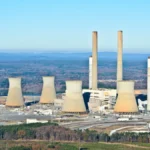Energy News Beat
Natural gas producers are bullish on demand as they see significant upside from the immense energy needs of artificial intelligence and data centers.
Electricity demand is forecast to grow 20% by 2030, according to Wells Fargo.
Power companies say gas is needed to meet demand when renewable energy sources are not generating enough power.
Natural gas producers are planning for a significant spike in demand over the next decade, as artificial intelligence drives a surge in electricity consumption that renewables may struggle to meet alone.
After a decade of flat power growth in the U.S., electricity demand is forecast to grow as much as 20% by 2030, according to a Wells Fargo analysis published in April. Power companies are moving to quickly secure energy as the rise of AI coincides with the expansion of domestic semiconductor and battery manufacturing as well as the electrification of the nation’s vehicle fleet.
AI data centers alone are expected to add about 323 terawatt hours of electricity demand in the U.S. by 2030, according to Wells Fargo. The forecast power demand from AI alone is seven times greater than New York City’s current annual electricity consumption of 48 terawatt hours. Goldman Sachs projects that data centers will represent 8% of total U.S. electricity consumption by the end of the decade.
The surge in power demand poses a challenge for Amazon, Google, Microsoft and Meta. The tech companies have committed to powering their data centers with renewables to slash carbon emissions. But solar and wind alone may be inadequate to meet the electricity load because they are dependent on variable weather, according to an April note from consulting firm Rystad Energy.
Surging electricity loads will require an energy source that can jump into the breach and meet spiking demand during conditions when renewables are not generating enough power, according to Rystad. The natural gas industry is betting gas will serve as the preferred choice.
“This type of need demonstrates that the emphasis on renewables as the only source of power is fatally flawed in terms of meeting the real demands of the market,” Richard Kinder, executive chairman of pipeline operator Kinder Morgan, told analysts during the company’s first-quarter earnings in April.
“The primary use of these data centers is big tech and I believe they’re beginning to recognize the role that natural gas and nuclear must play,” Kinder said during the call. Kinder Morgan is the largest natural gas pipeline operator in the U.S. with 40% market share.
Natural gas is expected to supply 60% of the power demand growth from AI and data centers, while renewables will provide the remaining 40%, according to Goldman Sachs’ report published in April.
Gas demand could increase by 10 billion cubic feet per day by 2030, according to Wells Fargo. This would represent a 28% increase over the 35 bcf/d that is currently consumed for electricity generation in the U.S, and a 10% increase over the nation’s total gas consumption of 100 bcf/d.
“That’s why people are getting more bullish on gas,” said Roger Read, an equity analyst and one of the authors of the Wells Fargo analysis, in an interview. “Those are some pretty high growth rates for a commodity.”
The demand forecasts, however, vary as analysts are just starting to piece together what data centers might mean for natural gas. Goldman expects a 3.3 bcf/d increase in gas demand, while Houston-based investment bank Tudor, Pickering, Holt & Co. sees a base case of 2.7 bcf/d and a high case of 8.5 bcf/d.
Powering the Southeast boom
Power companies will need energy that is reliable, affordable and can be deployed quickly to meet rising electricity demand, said Toby Rice, CEO of EQT Corp., the largest natural gas producer in the U.S.
“Speed to market matters,” Rice told CNBC’s “Money Movers” in late April. “This is going to be another differentiator for EQT and natural gas to take a very large amount of this market share.”
EQT is positioned to become a “key facilitator of the data center build-out” in the Southeast, Rice told analysts on the company’s earnings call in April.
The Southeast is the hottest data center market in the world with Northern Virginia in the thick of the boom, hosting more data centers than the next five largest markets in the U.S. combined. Some 70% of the world’s internet traffic passes through the region daily.
The power company Dominion Energy forecasts that demand from data centers in Northern Virginia will more than double from 3.3 gigawatts in 2023 to 7 gigawatts in 2030.
Further south, Georgia Power sees retail electricity sales growing 9% through 2028 with 80% of the demand coming from data centers, said Christopher Womack, CEO of Georgia Power’s parent Southern Company, during the utility’s fourt-quarter earnings call in February.
“Economic growth, electrification, accelerating data center expansion are driving the most significant demand growth in our company’s history and they show no signs of abating,” Dominion CEO Robert Blue said during the company’s March investor meeting.
The surging power demand in the Southeast lies at the doorstep of EQT’s asset base in the Appalachian Basin, Rice said during the earnings call. Coal plant retirements and data centers could result in 6 bcf/d of new natural gas demand in EQT’s backyard by 2030, the CEO said.
EQT recently purchased the owner of the Mountain Valley Pipeline, which connects prolific natural gas reserves that EQT is operating and developing in the Appalachian Basin to southern Virginia. EQT is the only producer that can access the growing data center market through the pipeline, said Jeremy Knop, the company’s chief financial officer.
“I think we are very uniquely positioned in that sense,” Knop said during the call. Rice said the Southeast will become an even more attractive gas market than the Gulf Coast later in the decade. EQT is planning to expand capacity on the Mountain Valley Pipeline from 2 bcf/d to 2.5 bcf/d. The pipeline is expected to become operational in June.
The level of electricity demand could help lift natural gas prices out of the doldrums.
Prices plunged as much more than 30% in the first quarter of 2024 on strong production, lower demand due to a mild winter and historic inventory levels in the U.S. By 2030, prices could average $3.50 per thousand cubic feet, a 46% increase over the 2024 average price of $2.39, according to Wells Fargo.
Grid reliability worries
Dominion laid out scenarios in its 2023 resource plan that would add anywhere from 0.9 to 9.3 gigawatts of new natural gas capacity over the next 25 years. The power company said gas turbines will be critical to fill gaps when production drops from renewable resources such as solar. The turbines would be dual use and able to take clean hydrogen at some point.
“We’re building a lot of renewables, which all of our customers are looking for, but we need to make sure that we can operate the system reliably,” Blue told analysts during Dominion’s earnings call Thursday.
Renewables will play a major role in meeting the demand but they face challenges that make gas look attractive through at least 2030, Read, the Wells Fargo analyst, told CNBC.
Many of the renewables will be installed in areas that are not immediately adjacent to data centers, he said. It will take time to build power lines to transport resources to areas of high demand, the analyst said.
Another constraint on renewables right now is the currently available battery technology is not efficient enough to power data centers 24 hours a day, said Zack Van Everen, director of research at investment Tudor, Pickering, Holt & Co.
Nuclear is a potential alternative to gas and has the advantage of providing carbon free energy, but new advanced technology that shortens typically long project timelines is likely a decade away from having a meaningful impact, according to Wells Fargo.
Robert Kinder, chief executive of pipeline operator Kinder Morgan, said significant amounts new nuclear capacity will not come online for the foreseeable future, and building power lines to connect distant renewables to the grid will take years. This means natural gas has to play an important role for years to come, Kinder said during the company’s earnings call in April.
“I think acceptance of this hypothesis will become even clearer as power demand increases over the coming months and years and it will be one more significant driver of growth in the demand for natural gas that will benefit all of us in the midstream sector,” Kinder said.
Environmental impact
Any expansion of natural gas in meeting U.S energy demand is likely to be met with opposition from environmental groups who want fossil fuels to be phased out as soon as possible.
Goldman Sachs forecast carbon emissions from data centers could more than double by 2030 to about 220 million tons, or 0.6% of global energy emissions, assuming natural gas provides the bulk of the power.
Virginia has mandated that all carbon-emitting plants be phased out by 2045. Dominion warned in its resource plan that the phase out date potentially raises system reliability and energy independence issues, with the company relying on purchasing capacity across state lines to meet demand.
Duke Energy CEO Lynn Good said natural gas “can be a difficult topic,” but the fossil fuel is responsible for 45% of the power company’s emissions reductions since 2005 as dirtier coal plants have been replaced. Good said electricity demand in North Carolina is growing at a pace not seen since the 1980s or 1990s.
“As we look at the next many years trying to find a way to expand a system to approach this growth, I think natural gas has a role to play,” Good said at the Columbia Global Energy Summit in New York City in April. The CEO said natural gas is needed as a “bridge fuel” until more advanced technology comes online.
“An all of the above strategy is the only thing that we see as the way to maintain the reliability and the affordability that our customers count on,” Good said.
The post AI could drive a natural gas boom as power companies face surging electricity demand appeared first on Energy News Beat.








